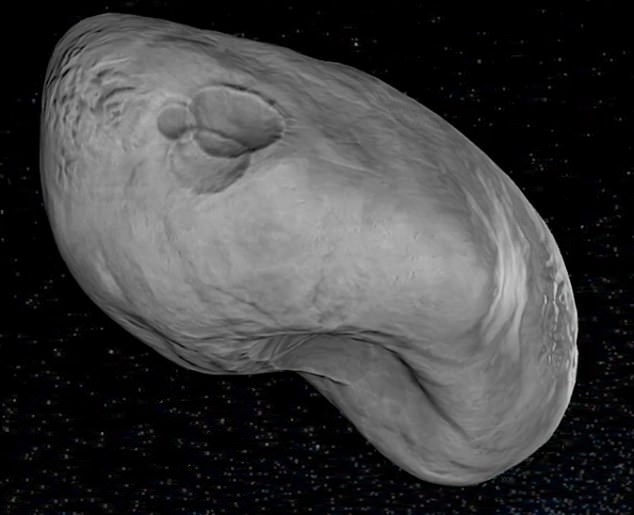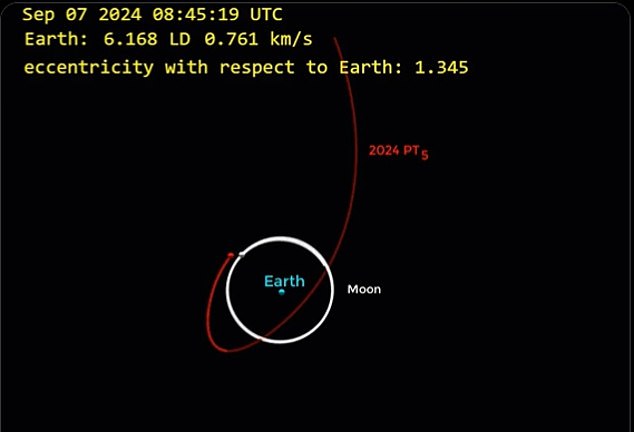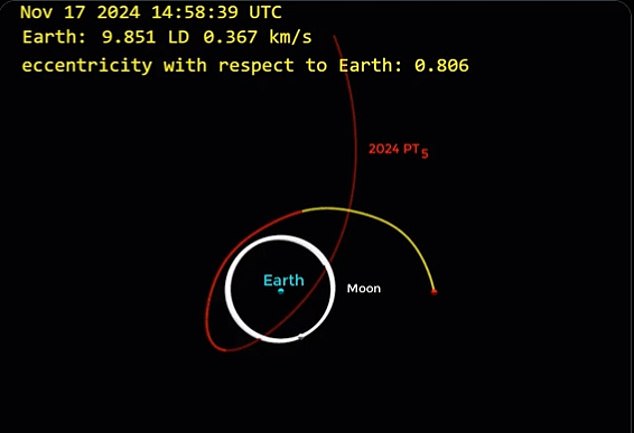Earth to get a new ‘mini-moon’ for more than 50 days
Earth will soon have a new cosmic companion, as a small asteroid is on its way to enter our planet’s orbit and will orbit the sun for about two months.
Starting on September 29, this “mini-moon” will make a single orbit around Earth before traveling to other parts of the solar system.
The 10-meter-wide asteroid, now named 2024 PT5, was first spotted on August 7 by NASA’s Asteroid Terrestrial-Impact Last Alert System (ATLAS). The system may be visible to certain telescopes.
Researchers tracked the orbit of the “mini-moon” and concluded that it will briefly be in Earth’s gravitational field, until November 25.
Asteroid 2024 PT5 will enter Earth’s orbit as a ‘mini-moon’ from September 29 to November 25 (stock)

Astronomers have created a simulation of what the asteroid looks like in space
When near-Earth objects – asteroids and comets – come within 45 million kilometers of Earth’s orbit, they follow a horseshoe-shaped path.
The orbit brings the objects closer to our planet with a low relative velocity, causing them to become temporarily trapped in Earth’s orbit, just like in 2024 PT5.
Previous research had already shown that this space rock poses no threat to Earth, but researchers from the Complutense University in Madrid who study asteroid dynamics suspected that the rock could temporarily settle in Earth’s gravitational field.
The researchers analyzed data on the asteroid’s size, travel speed and orbit to estimate the path the asteroid took in the two months following its discovery in August.
The research revealed that the space rock would enter orbit around Earth as a mini-moon from September 29 to November 25, orbiting our planet for 53 days before returning to space.
Tony Dunn, an amateur astronomer who creates orbital simulations, posted an animation of the path 2024 PT5 will take as it orbits our planet. Dunn was not involved in the research.
By observing the asteroid’s orbit, researchers were also able to trace its origin.
They concluded that it likely came from the Arjuna asteroid belt, a group of many asteroids with orbits around the sun similar to that of Earth.

Tony Dunn, an amateur astronomer who creates orbital simulations, posted an animation of the path 2024 PT5 will take as it orbits our planet

The asteroid will orbit our planet once before flying back into space
The researchers published their findings in the diary Research Notes from the American Astronomical Society.
But Paul Chodas, director of the Center for Near Earth Object Studies at NASA’s Jet Propulsion Laboratory (JPL), who was not involved in the research, told the New York Times that 2024 PT5 may have a different origin story.
The asteroid’s past motions suggest it “may be a piece of ejecta from an impact with the moon,” Chodas said. That means this mini-moon could be a fragment that broke away from our real moon.
Asteroid 2024 PT5 isn’t the first to hang around our planet for a while. In fact, this space rock is following a path similar to an earlier asteroid called 2022 NX1, which briefly became a mini-moon in 2022.
But there is some disagreement about whether this asteroid technically qualifies as a true mini-moon. To qualify, an asteroid must complete at least one full orbit around Earth.
“It’s certainly not going to complete a full orbit in the Earth-moon system this fall, so I’m not sure I would classify it as a mini-moon,” Lance Benner, principal investigator for the asteroid radar research program at NASA’s JPL, told the NYT. He was not involved in the study.
Regardless of how you classify this visiting orbiter, asteroids like 2024 PT5 serve as a reminder of all the celestial traffic that passes by Earth and the importance of studying the interactions between Earth and our planet.
